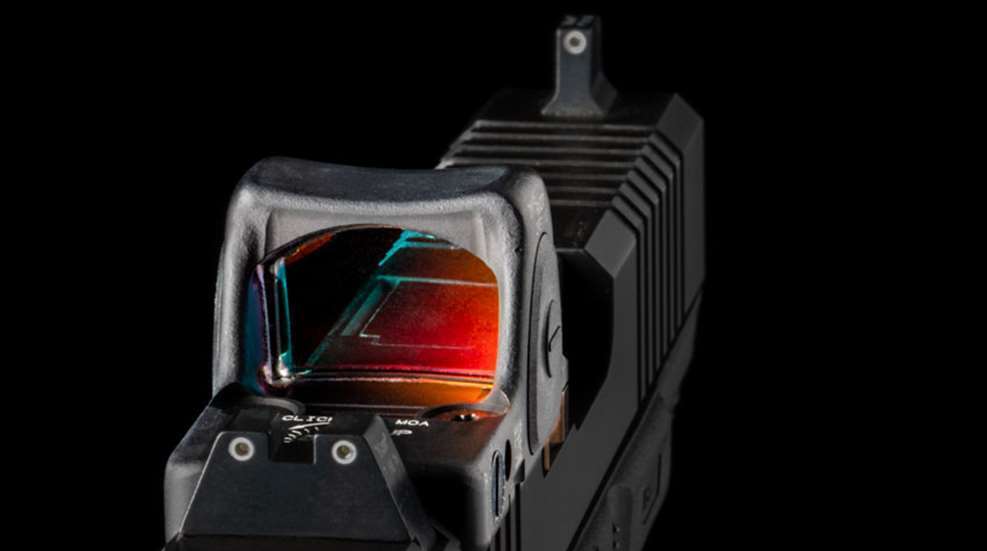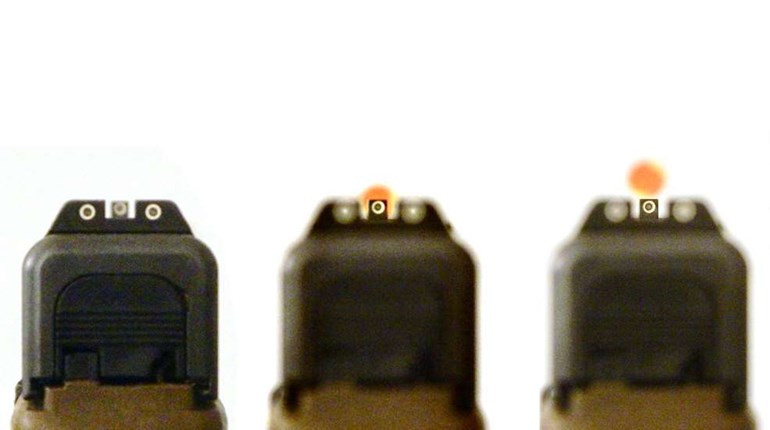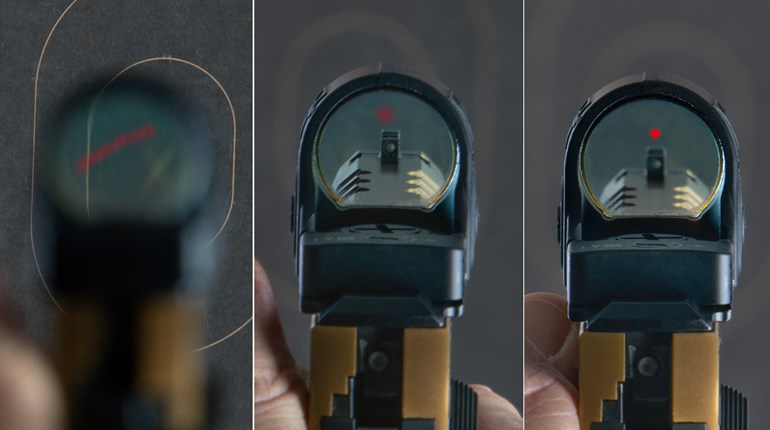
Shooting well is a process. It comprises a complex series of subprocesses that are performed at a specific level of competency to successfully hit a target within a specified amount of time. Several of these subprocesses are executed simultaneously.
The overarching shooting process is simply described as to bring stability to alignment (muzzle aligned with target) and press off a round without disturbing muzzle alignment.
One of the multiple subprocesses comprising the overarching process is the visual process which directs the shooter through a sighted-fire checklist including point of aim, alignment, confirmation, when to press and the results of that press including point of impact ultimately determining if it was a hit or a missed shot.
The visual process is responsible for three of the layered events that occur simultaneously throughout sighted-fire shooting: target focus, dot awareness and peripheral vision.
Target Focus
When running a red-dot system (RDS), there’s no other way to optimally perform if you are not target focused. What that means is to keep 100-percent, laser-focused on the target itself, like Superman drilling a hole in the target with his eyes. It takes a tremendous amount of visual energy (if you want to call it that) to keep such a hard focus.
Like another bad habit, knowingly or unknowingly altering your grip pressure (which is part of the mechanical or physical process), you may at times be tempted to let up on your visual focus which in turn immediately affects your alignment.
The concept here is comparable to driving 75 miles an hour on a freeway with your visual focus on the road. Visually drifting away from hard focus on the road and toward staring at the hood ornament or a bug on the inside of the windshield, would end in disaster. The same results occur with shot placement as it would with driving on a freeway at such speeds. Catastrophe can be readily avoided in both scenarios by maintaining hard visual target focus.
If shooting with iron sights, there is an added step to the visual process. It is to shift your focal plane from the target to a softer or nearer to front sight focus based on the technicality of the shot.
Dot Awareness
When shooting with a red-dot sight, you keep such a hard visual focus on the target that it becomes your primary focal point. However, you must simultaneously be aware of your red dot.
Another car driving analogy is placing your full and undivided attention on the road, but you are aware of whether your windshield wipers are on and at what speed they are flapping.
You don’t shift your hard visual focus from the slick road in front of you to the very tips of your wiper blades as they are moving. You simply are aware if the blades are switched on or off or are moving at the adequate speed needed for the amount of rainfall you may be experiencing.
Shifting your hard visual focus from the road to your wiper blades would cause a disaster.
Optimal visual technique when running an RDS is to maintain hard visual focus on the target while simultaneously being aware of the dot’s position in relation to the visual center of the target.
Although easier for more seasoned carry-optics shooters, it can be a bit challenging at first if you’ve been shooting irons all your life and today is the first day you’re switching over to a dot.
The iron sights equivalency of RDS dot awareness and being aware of the front sight in relation to the intended target area.
Your “soft focus” or “front sight awareness” (as some shooters call it) can shift anywhere from the target to in front of the iron sight or the very tip of the blade of the front sight depending upon the technicality of the shot.
Peripheral Vision
Given that you are maintaining a hard visual focus on the target, while simultaneously being aware of the dot’s position relative to the target, there’s only one way that you can observe what else is going on around you and that is by using your peripheral vision.
Peripherally observing what’s going on around you in a combative application may mean that you have engaged in a life or death situation with an active threat that must be stopped. If responding with a firearm, then you would need to know if the threat has been stopped or dropped to the ground.
Peripherally observing what’s going on around you in a competition application may mean addressing what are the next targets to be shot and/ or are there multiple procedural tasks within the shooting array.
Simultaneously maintaining hard target focus, dot awareness and peripheral vision throughout the shooting process is a learned skill. The visual process is what provides your sighted-fire confirmation and determines when you press the trigger. The old saying “let your eyes fire the gun” is a direct result of applying the visual process.
You can have the best gun handling skills in the world and the best physical mechanics, but when it comes to sighted fire, visual process is the heavyweight contender in shooting well.





































